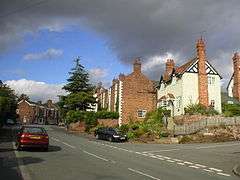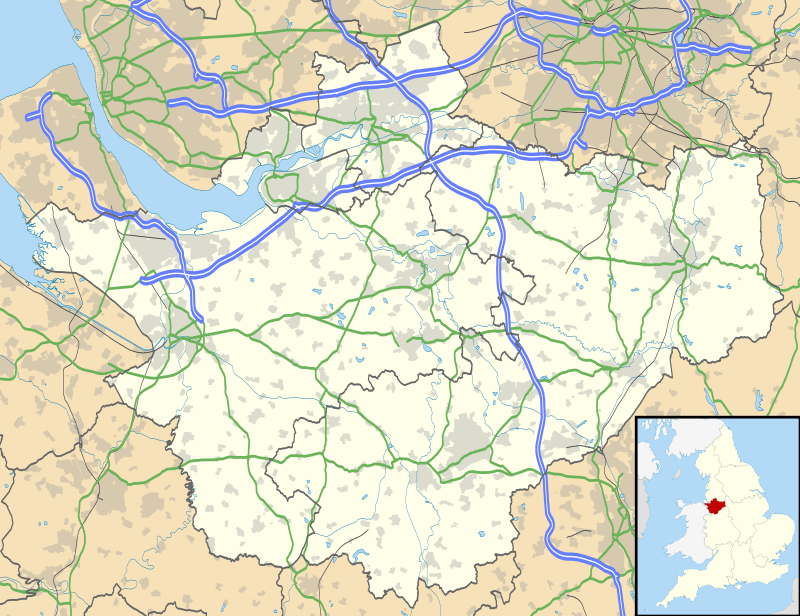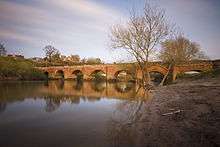Farndon, Cheshire
Farndon is a village and civil parish in the unitary authority of Cheshire West and Chester and the ceremonial county of Cheshire, England. It is on the banks of the River Dee, south of Chester, which here forms the England–Wales border. At the 2001 Census, the village had a population of 1,517,[2] increasing to 1,653 at the 2011 Census.[3] The Welsh village of Holt lies just over the River Dee from Farndon.
Farndon
| |
|---|---|
 Farndon village | |
 Farndon Location within Cheshire | |
| Population | 1,653 (2011 Census) |
| OS grid reference | SJ412545 |
| Civil parish |
|
| Unitary authority | |
| Ceremonial county | |
| Region | |
| Country | England |
| Sovereign state | United Kingdom |
| Post town | CHESTER |
| Postcode district | CH3 |
| Dialling code | 01829 |
| Police | Cheshire |
| Fire | Cheshire |
| Ambulance | North West |
| UK Parliament | |
Toponymy
The village's English name was first recorded in Old English in 924AD. It has been recorded as Fearndune, Farndune, Pharndoon, Ferentone, Ferendon, Faryngdon and Ferneton. The name means "Fern Hill".[4]
As Farndon is adjacent to the England–Wales border (Farndon Bridge across the River Dee separates the village from Holt, Wrexham), it is also known as Rhedynfre in Welsh. Its dual name reflects the area's historical importance as a place of conflict and cultural exchange since the Angles settled the area in the 8th century. As the political border moved back and forth during the following centuries, Farndon has been either part of Wales or England several times.
History
The area was inhabited during the Roman occupation of Britain.[5] Archaeological assessments in the village have concluded there was a Roman villa in the area or even a small military outpost.[6]
Edward the Elder, King of the Anglo-Saxons, died in the ancient parish of Farndon in AD 924, shortly after quelling a revolt of an alliance of Mercians and Welshmen. This involved Edward successfully taking Chester from the occupying Mercians and Welshmen, and then re-garrisoning it, and this happened shortly before his death.[4] Up to the 14th century, Farndon also included the chapelry of Holt in Denbighshire, Wales.
Some historians believe that Farndon was the location of the first ever competitive horse race with riders, in a local field on the banks of the River Dee. Nearby Chester Racecourse is said to be the oldest racecourse in Britain.
During the English Civil War, Farndon was the scene of bitter fighting over the Bridge that was controlling access to Chester from Wales. There is a fine memorial window in the parish church to the Civil War Royalists.
The village was at one time renowned for its strawberries, which were grown in the surrounding fields. This is no longer the case. The nearest fields are now in Holt.
Governance
There is an electoral ward that has the same name. This ward stretches from Saighton in the north to Church Shocklach in the south. The total population of this ward at the 2011 census was 4,011.[7]
Landmarks
Farndon Bridge spans the Dee connecting Farndon to the nearby Welsh village of Holt on higher ground. The bridge, made of sandstone and originally of Medieval construction, is said to be haunted. Holt Castle is located on the opposite side of the river; it was constructed in the 13th and 14th centuries. The castle fell to the forces of Oliver Cromwell in 1647.
Next to Farndon Bridge is a small picnic area beside the river. At the entrance to the picnic area are Farndon Cliffs. This area has been classed as a Site of Special Scientific Interest (SSSI). The sandstone cliffs contain interesting rock formations.[8]
St Chad's is the old parish church in Farndon. It is thought that some portions of the church date back to Sir Patrick de Bartun, a knight of King Edward III, whose effigy lies in the nave. The Church was damaged during the English Civil War and later repaired. The church contains a unique Civil War memorial window, and features an image thought to be that of William Lawes, the famous court musician, who was slain at the battle of Rowton Heath. The church tower still shows signs of Civil War musket ball damage.[9] The churchyard contains war graves of two British soldiers of World War I,[10] Sergeant Joseph Easter and Private Thomas Harrison.[11]
The village used to have four public houses: the Greyhound, the Nags Head, the Masons Arms and the Farndon Arms (formerly known as The Raven). Two of these, the Farndon Arms and the Nags Head, closed in the summer of 2007, though the Farndon Arms has since reopened as The Farndon; the Nags Head was demolished to make way for a small retail development. The Masons Arms closed in 1928 and has been a private residence since that time.[12]
A restaurant called The Brasserie closed late 2008. Since that time, the premises have reopened under the name of Little Churtons.
The village also has a Methodist Chapel at nearby Crewe by Farndon, a short walk from the village.
Notable residents
- Ricky Tomlinson has a holiday chalet on the banks for the River Dee, on the outskirts of Farndon.[13]
- Major Roger Barnston (1826–1857), served in the Crimean War and was killed in the Indian rebellion of 1857.[14]
- Paul Burrell, former butler to Diana, Princess of Wales, maintained a home in the village[15] and had a shop bearing his name, which he has since sold. It is now an antique shop called Botany House.
- John Speed (1542–1629), cartographer, was born in Farndon.[16]
- Bob Mills, comedian and host of In Bed With Medinner and Win Lose or Draw, spent his childhood in the village and attended the old site Primary School.[17]
Gallery of images
 Barnston monument
Barnston monument Farndon bridge
Farndon bridge
Notes and references
Notes
- "Home page". Farndon Parish Council. Retrieved 5 May 2020.
- "2001 Census: Farndon". Office for National Statistics. Retrieved 3 April 2008.
- "Parish population 2011". Retrieved 27 May 2015.
- Dodgson, J. McN. (1972). page 74.
- Fuller, Mike (29 September 2016). "Metal detectorist in Farndon found beautiful Roman pendant covered in mud". Chester Chronicle.
- "CHESHIRE HISTORIC TOWNS SURVEY: Farndon Archaeological Assessment" (PDF). www.cheshirearchaeology.org.uk. Retrieved 12 July 2018.
It has been suggested that a Roman road branched off Watling Street to Holt, crossing the River Dee at Farndon (Harris and Thacker 1987, 217–8), while the discovery of a hypocaust system at Crewe (CSMR 1787), 2km south-east of Farndon, suggests that this may have been the site of a Roman villa. Jones (1991, 77) has suggested that there might be an early Roman fort at Farndon, connected with the works depot at Holt.
- "Ward population 2011". Retrieved 27 May 2015.
- "Farndon Cliffs SSSI" (PDF). English Nature. Archived from the original (PDF) on 26 September 2007. Retrieved 7 July 2007.
- "Website of St Chad's, Farndon". St Chads Church. Retrieved 4 April 2008.
- "Cemetery Details: Farndom (St. Chad) Churchyard". Commonwealth War Graves Commission. Retrieved 15 June 2016.
- Royden, Mike (2016). Village at War – The Cheshire Village of Farndon During the First World War.
- "Website of Farndon Local History Pages". History. Retrieved 16 February 2011.
- "Ricky Tomlinson moves in to a £20,000 flat-packed chalet in Farndon". Cheshire Live. 28 May 2009. Retrieved 5 June 2020.
- "Obelisk commemorating Roger Barnston". Public Monument and Sculpture Association. Archived from the original on 15 August 2009. Retrieved 24 June 2006.
- Burrell, P. "Autobiography". Archived from the original on 15 July 2007. Retrieved 21 July 2008.
- Bendall (2004).
- Mills mentioned on his talkRADIO show that he was brought up in Ince Drive.
Bibliography
- Bendall, Sarah (2004). "Speed, John (1551/2–1629)". Oxford Dictionary of National Biography. Oxford University Press. doi:10.1093/ref:odnb/26093.
- Dodgson, J. McN. (1972). The place-names of Cheshire. Part four: The place-names of Broxton Hundred and Wirral Hundred. Cambridge: Cambridge University Press. ISBN 0-521-08247-1.
- Farndon Local History Group ed.Lathom, F. (1981). Farndon.
- www.farndon.org.uk Website of Farndon Local History Pages
- Royden, Mike, (2016). Village at War – The Cheshire Village of Farndon During the First World War, Reveille Press, ISBN 978-1908336699
External links
| Wikimedia Commons has media related to Farndon, Cheshire. |